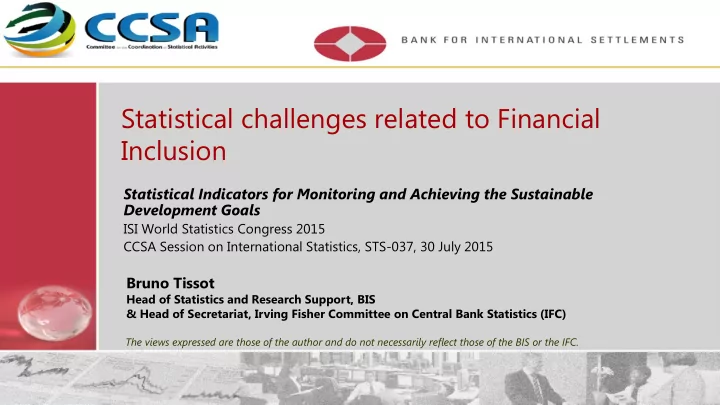

Statistical challenges related to Financial Inclusion Statistical Indicators for Monitoring and Achieving the Sustainable Development Goals ISI World Statistics Congress 2015 CCSA Session on International Statistics, STS-037, 30 July 2015 Bruno Tissot Head of Statistics and Research Support, BIS & Head of Secretariat, Irving Fisher Committee on Central Bank Statistics (IFC) The views expressed are those of the author and do not necessarily reflect those of the BIS or the IFC. Restricted
Highlights Financial inclusion and sustainable development 1. Data collection frameworks 2. Statistical challenges 3. Filling data gaps 4. Policy monitoring 5. Towards an analytical framework 6. 2 Restricted
1. Financial inclusion and sustainable development The concept of financial inclusion (FI) Access to formal financial services Multiform concept: quality of the services (NGOs) Services delivered in stable and properly regulated environment (public authorities) A key policy area FI can reduce poverty and increase well-being Economic development: allocation of resources & development of the financial system The FI “trinity”: complementing FI with financial literacy and consumer protection Balancing FI and financial stability International initiatives “Sasana accord” (Kuala Lumpur, 2013) Ongoing work by the Irving Fisher Committee on Central Bank Statistics (IFC) 3 Restricted
2. Financial inclusion data collection frameworks Several dimensions Accessibility / usage / quality / economic impact of financial inclusion Supply-side, top-down Demand-side, bottom up Micro versus Macro Micro aspects (granular data) Macro perspective (public policy implications) Several exercises, including G20 / Global Partnership for Financial Inclusion (GPFI) Global Financial Inclusion (Global Findex) Database - Gates Foundation IMF Financial Access Survey … Main issues: affordability (eg costs and other factors) / distance / eligibility 4 Restricted
3. Statistical challenges Supply-side Measure services and not individual access Lack of granularity Potential demand vs. actual observations Usage of financial services Sampling-type issues, costs Various audiences Cross-country comparisons Benchmarking needs & trade-offs FI indices (interpretation, coverage, relative meaningfulness) Quality of the underlying data is a prerequisite Temporal consistency Good policies require good data 5 Restricted
4. Filling data gaps Population coverage Households (inc. those engaged in production) SMEs Demand-side Consumer vulnerabilities Suitability of the services offered Potential usage Interactions and vicious cycles Miss-selling of products High fees Lower demand Puts a premium on qualitative assessments 6 Restricted
5. Policy monitoring Preventing vulnerabilities Excessive risk-taking & financial innovation Literacy Transparency Financial Deepening Monetary policy transmission Credit expansion and mobilisation of savings Leverage: level and speed Regulatory issues Light requirements? New providers of financial services Safe payment systems Regulation and proportionality: good calibration requires data 7 Restricted
6. A framework for assessing financial inclusion Calibrating public initiatives Diagnose Design Monitor Evaluate Refine Combining micro information and macro issues Best practices & quality aspects Cross-sectional Over time Good policies require good data 8 Restricted
Thank you Questions? bruno.tissot@bis.org IFC.secretariat@bis.org statistics@bis.org Selected BIS references: Irving Fisher Committee on Central Bank Statistics (IFC, 2015): Proceedings of the workshop on Financial Inclusion Indicators , IFC Bulletin no 38. Mehrotra A and J Yetman (2015): “ Financial inclusion – issues for central banks ”, BIS Quarterly Review, March. 9 Restricted
Recommend
More recommend